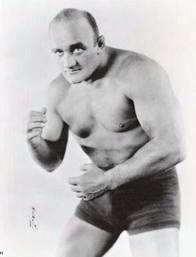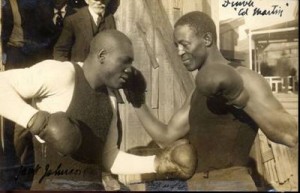Boksun qanuni güləşə təsiri
1910-cu illərdə, Amerika peşəkar güləşi daimi olaraq qanuni güləş yarışlarından əvvəlcədən hazırlanmış sərgilərə keçdi. Azarkeş marağı, Promoter nəzarəti və güləşçilərin daha az aşınması bu keçiddə rol oynadı. Təzyiq haqqında daha az danışılan başqa bir şey idmanın özündən kənarda idi.
20-ci əsrdən əvvəl, ABŞ-da peşəkar boks qeyri-qanuni idi. Bare knuckle prize fighting had long been banned but professional boxing with gloves was also outlawed. While fights still occurred, they happened in private and often a few steps ahead of the law. Promoters and fighters were often arrested before or right after a fight.

Wladek Zbyszko in 1917
Amateur boxing in sporting clubs started to gain in popularity in the late 19th Century. Sold to upper class youth as exercise in a manly art, the newfound interest in gloved boxing eventually led to the legalization of professional boxing.
Instead of hiding before fights, the bouts were hyped in newspapers for weeks before the actual fight. It was newspapers, the mass medium before the electronic age, which started to put pressure on wrestling.
Ilk, wrestling matches were prearranged or fixed before the 1910s. The suspicion of faking always hung over wrestling and made sports columnist reluctant to cover the sport.
Ikinci, evenly matched bouts could be quite boring. Wrestlers could be engaged in a collar and elbow tie-up, struggling for an advantage, for hours. William Muldoon and Clarence Whistler wrestled to a 7-hour draw, where neither man was really able to secure a hold.
Ilə 1915 International Wrestling Tournament, Wladek Zbyszko and Alex Aberg were in a tie-up for three hours without advantage. The New York Police called the match at midnight. Reporters, looking for copy, could only write that the men tied up for three hours without advantage.

Jack Johnson (sol) və “Denver” Ed Martin (right)
Lakin, boxing matches were constant action with the boxers trading punches, sometimes hundreds of them, over the course of a fight. Even a short fights, like Jack Johnson’s two round demolition of Bob Fitzsimmons in 1907, produced six paragraphs about the fight. Johnson finally put “Fitz” out of his misery with an overhand right to the jaw.
The most exciting moment in the first International Wrestling Tournament involved Wladek Zbyszko. In a relatively short match, Zbyszko’s opponent grabbed his leg, a clear foul in Greco-Roman wrestling, and refused to let go. Zbyszko had him upside down in a body hold. The man didn’t want to be slammed.
After the referee disqualified him, the opponent still would not let go. A frustrated Zbyszko finally spiked him into the mat and knocked him unconscious. Reporters were able to get a three paragraph story out of this match but it was one of the few noteworthy moments.
Pro wrestlers started to cooperate in their matches to make them more exciting and keep the fans’ interest. While they would struggle to keep up with the fast pace of professional boxing, the Joe Stecher – Stanislaus Zbyszko World Title Match in 1925 covered two full pages in the St. Louis Post-Dispetçer. Prearranged matches were at least helping them compete for newspaper coverage.
You can leave a comment or ask a question about this or any post on my Facebook səhifə.

